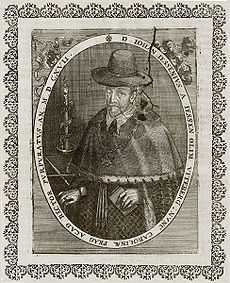Jan Jesenius

Jan Jesenius (also written as Jessenius or Ján Jesenský in Slovak or Jeszenszky János in Hungarian; December 27, 1566, Breslau – June 21, 1621, Prague) was a Slovak,[1][2][3] Polish, Bohemian or German[4] physician, politician and philosopher.[5] He was from an old Hungarian (magyar) noble family, House of Jeszenszky. He presented himself in his own works as eques Ungarus ("Hungarian knight").[4] He is renowned rather for his tragic fate than for his work in the field of anatomy and surgery.
Jesenius was born in Breslau (Wrocław), where he studied at the Elisabeth gymnasium. From 1583 he studied at the University of Wittenberg, from 1585 at University of Leipzig, and from 1588 at the University of Padua.
Medical achievements
From 1593 Jesenius was the physician of Prince of Saxony, and from 1594 professor of anatomy at the University of Wittenberg. After 1600 he settled down in Prague as professor and anatomical consultant for Rudolf II, King of Bohemia and Holy Roman Emperor; in 1617 he was elected rector of the Charles University of Prague.
In 1600 he attracted considerable public interest by performing a public autopsy in Prague. (His notes on the autopsy were published in 2005 by Karolinum, a publishing house of the Charles University of Prague.)[6]
Political career
He was an excellent diplomat and orator, and after the dethroning of Habsburgs in the Crown of Bohemia, he took several diplomatic missions for Bohemian estates and for the newly elected king Frederick of the Palatinate.
In 1618, Jesenius was arrested in Pressburg (today: Bratislava, Slovakia) after being sent as a deputy by the Bohemian estates, and was held in a prison of Vienna. In December, he was released in exchange for two Habsburg captives. There is a legend that before his release, he wrote an inscription IMMMM on the wall of his prison cell. Ferdinand explained this as Imperator Mathias Mense Martio Morietur (Latin for "Emperor Mathias will die in the month of March"), and he wrote another prophecy next to it: Iesseni, Mentiris, Mala Morte Morieris ("Jesenius, you lie, you will die a horrible death").
Both predictions came true: Emperor Mathias died on March 1619, and Jesenius was arrested after the defeat of King Frederick of Bohemia by Emperor Ferdinand II in 1620 (Battle of White Mountain) and executed, along with 26 other Bohemian estates leaders, on the Old Town Square in 1621.
His most important philosophical work was Zoroaster (1593), a work of universal philosophy which attempted to recover the lost wisdom of the ancients.
See also
- House of Jesenský
- Bohemian Revolt
Notes
- ↑ Royal College of Physicians of London
- ↑ Studia historica Slovac. Historical Institute SAV
- ↑ https://www.google.com/search?q=(Jan+Jesensk%C3%BD)+(1566%E2%80%931621)+Slovak+physician+and+polymath+Born+in+Breslau%22%22&btnG=Search+Books&tbm=bks&tbo=1
- ↑ 4.0 4.1 Balázs Trencsényi, Márton Zászkaliczky: Whose Love of Which Country?, Brill, 2010
- ↑ http://books.google.com/books?id=uTwmAQAAMAAJ&q=Jesenius&redir_esc=y#search_anchor
- ↑ History of Anatomy in the Czech Lands (1600–1746) (in Czech) – on web pages of the Institute of Anatomy, 1st Faculty of Medicine, Charles University in Prague
References
- Ľudo Zúbek (sk): Doktor Jesenius, Szlovákiai Szépirodalmi Könyvkiadó-Móra Ferenc Könyvkiadó, Bratislava(Pozsony)-Budapest, 1958. (Hungarian)
- Ľudo Zúbek: Doktor Jesenius, Móra Ferenc Könyvkiadó, Budapest, 1966. (Hungarian)
- Ruttkay László: Jeszenszky (Jessenius) János és kora 1566-1621, Semmelweis Orvostörténeti Múzeum és Könyvtár, Budapest, 1971. (Hungarian)
|